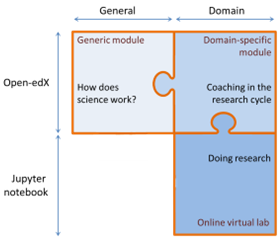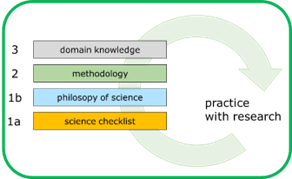Project introduction and background information
The academic education of students must prepare them for a future – within or outside science – in which scientific knowledge plays an important role. It is therefore essential that students have a good understanding of how scientific knowledge is created and what their role is in this. The core of modern science is the scientific method. Although it can take various forms in practice, the scientific method includes a number of essential steps: asking a question – formulating a hypothesis – conducting an experiment – confirming or rejecting the hypothesis – in order to then be able to ask a deeper or more precise question.
Students need this systematic approach during their studies as soon as they start doing research themselves during their BSc or MSc thesis. But they will also benefit from a conscious use of the scientific method in their future career in fundamental or applied research. The aim of this project is to prepare students for this. It is not enough to tell them how science works: they have to learn to work as scientists themselves. At the same time, they must become aware of the limitations of the reductionism and materialism inherent in the scientific method.
Objective and expected outcomes
Within the project, we want to develop a modular online course in which students not only learn the essential steps of the scientific method but also practice them. The course will consist of three modules (see figure on the right), some of which can also be used separately:
- Generic module. In this module, students are introduced to the scientific method: what steps do scientists take to arrive at new knowledge, and why are these steps so essential. In addition, attention is paid to reflection on science and on philosophical questions such as 'what are facts?', 'what is progress?'.
- Discipline-specific module. In this module, students are guided through the steps of the scientific method by conducting their own research: first guided, later more freely. As in science, peer-to-peer feedback is an important aspect here. Because a research object is required for conducting research, this module focuses on a specific research domain, namely the environmental sciences.
- Online virtual lab. Students conduct the actual research in an online virtual laboratory. This laboratory is based on a model that describes the coupled processes in the lowest kilometers of the atmosphere above land: the layer in which we live and in which a large part of the biosphere is located.
Essential features of the project are:
- We bring together the theory and practice of the scientific method in a course: students practice the method by doing meaningful research.
- We bring together generic information and discussion about science with domain-specific research. By splitting into modules, the concept of the course is reusable in other disciplines within and outside Wageningen.
- The course is offered online, which enables distance learning and just-in-time teaching (just before the start of thesis work) and makes the course applicable in a blended learning design of education.
- The virtual lab will be based on the CLASS model (Chemistry Land-surface Atmosphere Soil Slab, see http://classmodel.github.io) with which research can be done on processes in soil, vegetation and atmosphere. There is many years of experience with the use of this (currently offline) model in education (within/outside Wageningen, at BSc, MSc and PhD level).

Results and learnings
Design process the first pilots with students, it became clear that this setup did not work well, because students were not able to see the connection between the various elements:
- between knowledge about science as an activity and philosophy of science
- between philosophy of science and the scientific method
- between philosophy of science and the knowledge of their own domain
This feedback has made us reconsider the setup radically. We decided to interweave the various aspects much more tightly. We realised that this stronger integration would endanger the intended modularity of the course. However, the course would gain in relevance to the students.

The overall design of the course is illustrated below. The four rows indicate the four learning paths. Within each of the first four modules the research activity connects the learning paths. The last two modules are devoted to a research project, consisting of the design of the research (incl. proposal writing) and the performance of the study (incl. report writing).

All deliverables are accessible via a website: https://scientific-method-course.github.io
The transferable deliverables include:
- The online course in EdX-Edge (freely accessible after registration). The copy of the course that is publicly available should be considered a read-only course in the sense that we do not guarantee that student input is archived. For instructors who want to use the course, they can provide a separate copy in which their own students can use the course.
- The description of the learning paths on:
- Philosophy of science in relation to the scientific method
- The personal science checklist in which students reflect on their own principles regarding scientific research.
- The scientific method
- Theory of cloud formation in the atmospheric boundary layer (domain-specific).
- Videos, illustrations and documents (writing instructions; assessment rubrics for research proposal and report).
- Prototype of the online virtual laboratory (including access to the source code).
Recommendations
Lessons learned:
- Expert support is essential (preferably within the institution). This concerns both the didactics of online education and the technical and implementation side.
- Test your product with students from an early stage in the development process. Even the most rudimentary prototype (or small part of the material) can be sufficient to receive important feedback that can guide the design process.
- Evaluate during the process whether the proposed design still fits: if it turns out that the design was unnecessarily complex, simplify the plan, while retaining the essential goals of the project.
- Do not develop two things at the same time: the combination of the development of a completely new curriculum with the development of an online subject makes the project too complex.
- Reuse what you can reuse, even if you may have to make concessions to the unity of the total product that you are developing.
- Creative Commons: all members of the team (the larger, the more difficult) must be imbued with the essentials of CC licensing.
- When developing in a team that has not worked together before: make sure that everyone has the same idea of what is being developed, and do not mistake enthusiasm of team members for commitment.
- Start preparations quickly as soon as allocation is known (especially if temporary staff has to be hired).
Practical outcomes
The developed online course has been integrated in a blended course that is offered to students of the BSc programmes of Soil, Water, Atmosphere, and Environmental Sciences (see https://courses.wur.nl/MAQ52806).
